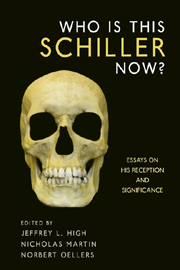Book contents
- Frontmatter
- Contents
- Foreword
- Acknowledgments
- List of Abbreviations
- Introduction: Why Is This Schiller [Still] in the United States?
- Part I Schiller, Drama, and Poetry
- Part II Schiller, Aesthetics, and Philosophy
- Part III Schiller, History, and Politics
- Part IV Schiller Reception — Reception and Schiller
- 17 Schiller and the Gothic — Reception and Reality
- 18 Schiller's Plays on the British Stage, 1797–1825
- 19 From Martyr to Vampire: The Figure of Mary Stuart in Drama from Vondel to Swinburne
- 20 A Chapter of Schiller in America: The First World War and Volume 3 of Kuno Francke's Edition of The German Classics
- 21 The Reluctant Recruit? Schiller in the Trenches, 1914–1918
- 22 Schiller — Kommerell — George. Eine Konstellation der Moderne
- 23 Was sagte dieser Schiller (damals)? Schillers Antworten auf seine Kritiker nach 1945
- Part V Schiller Now
- Notes on the Contributors
- Index
19 - From Martyr to Vampire: The Figure of Mary Stuart in Drama from Vondel to Swinburne
from Part IV - Schiller Reception — Reception and Schiller
Published online by Cambridge University Press: 05 February 2013
- Frontmatter
- Contents
- Foreword
- Acknowledgments
- List of Abbreviations
- Introduction: Why Is This Schiller [Still] in the United States?
- Part I Schiller, Drama, and Poetry
- Part II Schiller, Aesthetics, and Philosophy
- Part III Schiller, History, and Politics
- Part IV Schiller Reception — Reception and Schiller
- 17 Schiller and the Gothic — Reception and Reality
- 18 Schiller's Plays on the British Stage, 1797–1825
- 19 From Martyr to Vampire: The Figure of Mary Stuart in Drama from Vondel to Swinburne
- 20 A Chapter of Schiller in America: The First World War and Volume 3 of Kuno Francke's Edition of The German Classics
- 21 The Reluctant Recruit? Schiller in the Trenches, 1914–1918
- 22 Schiller — Kommerell — George. Eine Konstellation der Moderne
- 23 Was sagte dieser Schiller (damals)? Schillers Antworten auf seine Kritiker nach 1945
- Part V Schiller Now
- Notes on the Contributors
- Index
Summary
Most literary representations of Mary Stuart focus on one of three aspects of her being: martyr, queen, or seductive/destructive woman. Schiller's achievement was to combine all three, portraying her as fascinating but unstable: hence the variety of interpretations and receptions of his play. After surveying representations of Mary Stuart as martyr, beautiful woman, and/or erotic and political rival to Elizabeth in some seventeenth-century dramas, this paper shows how Schiller combines these elements and how in the nineteenth century his synthesis breaks apart. Mary becomes a romantic heroine, even a decadent femme fatale, only rarely a serious political player. The conflicting reception of this figure helps us to appreciate the complexity of Schiller's play, in which diverse images of Mary are present as images corresponding to the subjective perceptions of the person who expresses them.
IN THIS MODIFIED EXERCISE IN THEMATICS, or as Germans call it “Stoffund Motivgeschichte,” I hope to avoid at least one of the faults that have brought such an approach into some disrepute. That is, treating all literary works that deal with the same material as equal in value, so that acknowledged masterpieces and ephemeral productions are treated as equivalent and the latter are resurrected for no apparent purpose other than thoroughness. Instead, by looking at a selection of plays about Mary Stuart before and after Schiller, I hope to show that Schiller's Maria Stuart (Mary Stuart, 1800) incorporates an exceptionally wide range of approaches to the material, and this range gives it the complexity and density that suits a literary masterpiece.
- Type
- Chapter
- Information
- Who Is This Schiller Now?Essays on his Reception and Significance, pp. 321 - 339Publisher: Boydell & BrewerPrint publication year: 2011



